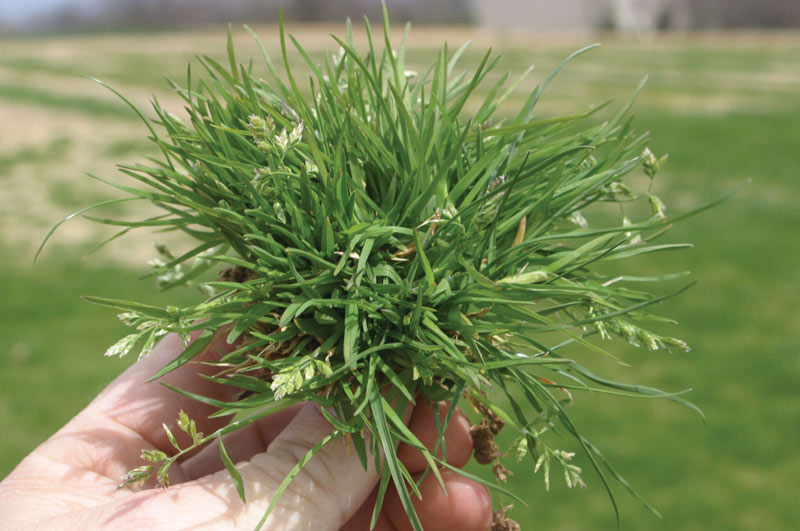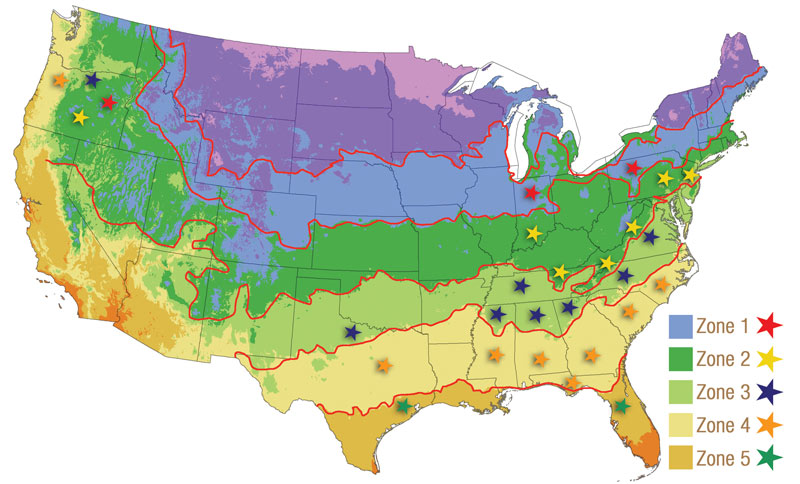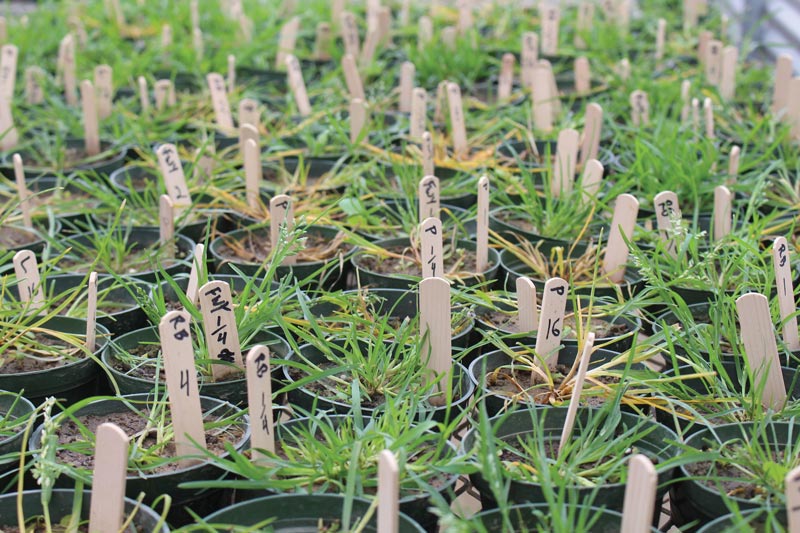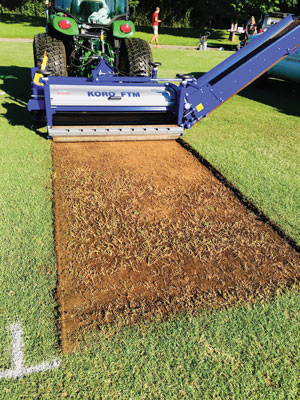
Annual bluegrass (Poa annua L.) is a low-growing, cool-season grass that grows in dense tufts. Photo by Shawn Askew
In a 2015 survey conducted by the Weed Science Society of America, annual bluegrass (Poa annua L.) was identified as the most troublesome weed in managed turfgrass systems throughout the United States (2). Annual bluegrass impacts most turfgrass systems, from sod farms to golf courses, and often causes severe economic losses.
Poa annua is a problem so widespread that its presence has been observed on all continents, including Antarctica, although it is most prominent in temperate climates. Annual bluegrass has high levels of genetic diversity and can rapidly adapt to different climates and management programs, making it particularly challenging to control.
Existing annual bluegrass management programs rely heavily on herbicides in all four major turf sectors (golf, sod production, athletic fields and residential lawns). Turfgrass facilities can easily spend hundreds of dollars per acre to manage annual bluegrass on their premises. In an effort to cut costs, many turfgrass managers may choose to use less expensive products, limiting the types of chemistries used.
When the same few herbicides are used frequently with little diversity in management practices, there is an increased risk of herbicide resistance. Annual bluegrass has been shown to quickly develop resistance to herbicides and is ranked third among all herbicide-resistant weed species globally, with resistance to at least nine herbicide sites of action (1).
A team of 17 university scientists has embarked on a $5.7 million project to limit the impact of annual bluegrass. The team’s multifaceted approach, funded by the USDA and the National Institute of Food and Agriculture, involves characterizing the nationwide distribution of herbicide-resistant populations, seeking weaknesses in the weed’s seed biology and growth characteristics, and developing alternatives to herbicides to supplement current control measures.
This article has been written to introduce turfgrass managers in the golf industry to the broad spectrum of work being performed by providing the names and locations of the project leaders and describing the eight objectives of this research.
Who is involved?
Seventeen faculty members from 15 universities are involved in the USDA-SCRI (Specialty Crop Research Initiative) Poa project:
Jennifer H. Allen, Ph.D.
Associate professor
Portland State University
Shawn Askew, Ph.D.
Professor
Virginia Tech
Muthu Bagavathiannan, Ph.D.*
Associate professor
Texas A&M University
Jim Brosnan, Ph.D.
Professor
University of Tennessee
Matthew Elmore, Ph.D.
Assistant professor
Rutgers University
David Ervin, Ph.D.
Professor emeritus
Portland State University
George Frisvold, Ph.D.
Professor
University of Arizona
Travis Gannon, Ph.D.
Associate professor
North Carolina State University
Becky Grubbs, Ph.D.
Assistant professor
Texas A&M University
John Kaminski, Ph.D.
Professor
Penn State University
Alec Kowalewski, Ph.D.
Associate professor
Oregon State University
Bert McCarty, Ph.D.
Professor
Clemson University
Patrick McCullough, Ph.D.
Associate professor
University of Georgia
Jay McCurdy, Ph.D.
Assistant professor
Mississippi State University
Scott McElroy, Ph.D.
Professor
Auburn University
Aaron Patton, Ph.D.
Professor
Purdue University
Bryan Unruh, Ph.D.
Professor
University of Florida
* Dr. Bagavathiannan serves as the primary investigator and project leader for this grant.
In addition to these project leaders, more than 20 students and support staff are directly involved in the work, which extends across at least 14 states.
What are the objectives of the work, and how is the project designed?
This research project has eight overarching objectives, several with subobjectives designed to be as thorough as possible in exploring every aspect of the annual bluegrass epidemic. Each objective is briefly summarized below.
Objective 1: Conduct field surveys and document the extent of annual bluegrass resistance to key turfgrass herbicides, and develop methods for rapid resistance detection.

Figure 1. Delineation of survey zones for Objective 1 based on the USDA plant hardiness map.
A series of field surveys is being conducted to collect escaped plant populations across five unique hardiness zones (Figure 1, above) in each of four turfgrass systems (golf courses, athletic fields, home lawns and sod farms). Researchers will collect at least 2,000 unique populations, equally distributed across each hardiness zone and turfgrass system, for subsequent herbicide screenings. To date, more than 1,000 populations have been collected, and project leaders are on track to complete field surveys in 2020.
After collection, each population is subjected to a series of resistance and susceptibility screenings to key pre- and post-emergence herbicides commonly used in turfgrass weed management (Table 2). Herbicide dose-response rates used for this objective range from 0× (control) to as high as 8× (1× = recommended label rate), depending on the type of herbicide and whether the population has been classified as “resistant” or “susceptible” in initial evaluations.
In addition to carrying out field screenings, researchers are seeking to determine whether resistant populations of annual bluegrass are being spread across the U.S. from seed production fields. In an effort to test turfgrass seed sources for contamination of resistant annual bluegrass, select project leaders will be collecting annual bluegrass seed from seed cleaners and certified seed lots. An anticipated 200 samples will be germinated and propagated to evaluate the extent of herbicide resistance to the herbicides listed in Table 2.
Furthermore, researchers are seeking to develop and refine rapid diagnostic assays for annual bluegrass resistance to some key inhibiting herbicides used in turf systems. Two approaches are being evaluated, including an agar culture method and a leaf incubation method in which annual bluegrass samples are exposed to variable rates of select herbicides and evaluated for resistance. Each of these methods has applications for specific scenarios and herbicides and may help researchers diagnose resistance more quickly in the future.
Objective 2: Better understand the mechanisms of resistance in annual bluegrass.
Mechanisms of resistance refer to how plants are able to tolerate herbicide applications. A primary objective of this work is to better understand how resistance is occurring in annual bluegrass populations at the physiological and molecular levels.
The two mechanisms being evaluated in this work are target-site resistance and non-target-site resistance. Target-site resistance occurs when the intended location for herbicide binding undergoes a change in structure. This change prevents or reduces the binding of the herbicide, inhibiting its effectiveness. Researchers will be evaluating target-site resistance and genetic relationships in subsamples of resistant populations from each turfgrass sector and hardiness zone.


In early spring 2019, herbicide screenings were carried out at Mississippi State University in Starkville, Miss., to evaluate annual bluegrass response to select herbicides used in turfgrass management. Photos by Jay McCurdy
Non-target-site resistance can occur as a result of decreased herbicide absorption or translocation, as well as enhanced breakdown (that is, plant metabolism) of the herbicide. This research seeks to better understand non-target-site resistance to ALS- and PSII-inhibiting herbicides (Table 2) as well as glyphosate. Resistant populations identified in the initial screening will be selected to investigate any differences in absorption (foliar as well as root), translocation and metabolism. Susceptible populations from each turfgrass system will be included in both studies for comparison.
Objective 3: Better understand the biology and ecology of annual bluegrass.
It has been hypothesized that annual bluegrass exhibits prolonged seed persistence in soil and has an extended seedling emergence period, continuing to germinate later in the season than some other winter annual weeds. This can make it difficult to effectively time and target herbicide applications.
Studies evaluating seed persistence and germination at variable depths, as well as the seedling emergence period, may help to more effectively time herbicide application programs for more effective control. At seven distinct locations, a common garden of annual bluegrass will be established, with each garden using seed from 10 locations, in order to gain a deeper understanding of diversity in phenotypic and adaptive traits in this dynamic plant.
Objective 4: Evaluate and optimize integrated weed management programs for control of annual bluegrass.
To effectively overcome herbicide resistance, it is important for turfgrass managers to establish successful integrated weed management programs that rely on the integration of tools such as mechanical and cultural control practices to supplement chemical options and achieve effective and sustainable weed control. In order to achieve this, researchers will engage in multiple experiments that evaluate the following alternative approaches to annual bluegrass control.
Cultural control
Different aspects of cultural control and their effects on annual bluegrass management are being evaluated, including mowing, irrigation and nutrient management practices, along with turfgrass species and cultivar selection. Studies are being conducted in the laboratory, greenhouse and field to determine which cultural practices favor healthy turfgrass growth while reducing annual bluegrass populations.
Alternatives to conventional herbicides
In an effort to exhaust all possible control options, participating researchers are seeking to evaluate the efficacy of alternatives to conventional herbicides. Several non-synthetic chemical products and alternative compounds are being assessed, including Fiesta (Neudorff North America), Thaxtomin A (Cayman Chemical Co.), Civitas Turf Defense (mineral oil, Intelligro), corn gluten meal (fall pre-emergence), concentrated acetic acid (40%), baking soda, hydrated lime, and high rates of zinc and ferrous sulfate. Each will be applied at three growth stages on four turfgrass species important to each location, along with a bare-ground treatment.

Right: Fraze mowing was conducted in summer 2019 at the University of Tennessee turfgrass research facility in Knoxville, Tenn. Photo by Jim Brosnan
Mechanical control
Fraze mowing, or the removal of the uppermost layer of a turfgrass area, is being evaluated as a mechanical control option capable of removing high volumes of annual bluegrass seed from infested sites. In this study, fraze mowing is being performed on both bermudagrass and zoysiagrass at three timings (May, June and July) and three mowing depths of 0, 0.59 and 1.18 inches (0, 1.5 and 3 centimeters). The number of annual bluegrass plants in each plot will be counted each winter and spring following fraze mowing. The plots will be irrigated and maintained as required, but no herbicide applications will be made throughout the study. Annual bluegrass pressure will be evaluated, and recovery of the turfgrass species in fraze-mowed plots will be assessed using digital image analysis.
Objective 5: Survey turfgrass managers and find effective ways for communicating best management practices (BMPs) and creating widespread change.
This socioeconomic component involves a series of surveys and focus groups designed to engage turfgrass managers throughout the industry in order to gain valuable information from their experiences in controlling annual bluegrass and managing resistance issues in turfgrass systems. In addition to learning more about common turfgrass and weed management practices employed by turf managers nationwide, researchers hope to identify key roadblocks to adopting BMPs recommended for preventing or addressing herbicide resistance challenges. These impediments may include budgets, municipal ordinances, environmental challenges and cultural barriers.
An additional two-part study will be performed to evaluate the economic impact of preventing and managing herbicide resistance in annual bluegrass. The first component of this study will model biological speed of resistance evolution (how quickly a problem can develop and spread), the effect of resistance management on that development, and the overall economic consequences of resistance management. The second component will involve surveying turfgrass managers to better understand the economic implications of turfgrass weed management and the adoption of resistance management practices.
Objective 6: Develop a user-friendly support tool that helps turfgrass managers implement BMPs for control of annual bluegrass.
Research scientists understand the importance of an effective method for communicating BMPs to turfgrass managers. As new information is gathered from each component of this project, it will be incorporated into a user-friendly decision-support tool, which will allow turf managers to have easy access to all pertinent information gained from this work to incorporate into their day-to-day management practices.
Ideally, this tool will simulate long-term soil seedbank density of annual bluegrass as well as costs over a multi-year period. This decision-support tool will provide users with a broader picture of the long-term implications of overall management practices rather than focusing on the short term. The tool will help turf managers plan effective long-term programs and provide data-based justifications for proposed budgets and management plans.
Objective 7: Develop and deliver a comprehensive Extension program for sustainable management of annual bluegrass.
Several turfgrass Extension specialists are involved with the USDA-SCRI Poa project and plan to work together to design a comprehensive Extension program for the sustainable management of annual bluegrass turf systems. The program will be developed in close collaboration with industry stakeholders to clearly identify and articulate BMPs and provide effective tools for disseminating information to a broad audience. Extension specialists also hope to be in a position to assess the adoption and impact of BMPs through their close relationships with turfgrass managers.
As part of this Extension effort, a website, Resist Poa, has already been launched and is available to the public. Twitter users can keep up with project progress by following @ResistPoa.
Objective 8: Provide new educational opportunities that train the next generation of turfgrass researchers, Extension scientists and turf managers.
The final objective of this project involves the design and implementation of educational programs that support the professional development of future turfgrass managers. Information gained from the project will be incorporated into the curricula of at least 24 individual courses taught at participating institutions, including Penn State University, Oregon State University, Auburn University, Texas A&M University, Mississippi State University, North Carolina State University, Virginia Tech, Purdue University, University of Arizona, Clemson University, University of Georgia and Rutgers University. This will allow the next generation of turfgrass educators, scientists and managers to gain valuable knowledge from the work performed in this project and share that knowledge further with those they train and educate.
Research timeline
This project was initiated in fall 2018 and is scheduled to continue through summer 2022. As each experiment is completed, work will be submitted for publication to appropriate peer-reviewed journals. It is our intention also to share findings from critical components of this work here in GCM so that you, the reader, have access to our latest findings. We are excited to share these efforts with you, and we encourage you to follow along as we complete work that, we hope, will make a significant contribution to the turfgrass industry.
Funding
This project was funded by the USDA-NIFA Specialty Crop Research Initiative (SCRI) program (award: 2018-51181-28436).
The research says ...
- With a $5.7 million USDA grant, a group of scientists is attempting to tame Poa annua, turf’s most troublesome weed.
- Seventeen faculty members from 15 universities are working on the project with students and support staff in at least 14 states.
- The project has eight objectives including to better understand the biology and ecology and the mechanisms of resistance in Poa annua and to evaluate and optimize integrated weed management programs for Poa control.
- The objectives also include developing BMPs for Poa annua control, providing a support tool for implementing the BMPs, developing an Extension program and delivering educational opportunities to academics and turf managers.
Literature cited
- Tranel, P.J., T.R. Wright and I.M. Heap. 2019. The International Survey of Herbicide Resistant Weeds. Weed Science Society of America. (http://www.weedscience.org/Mutations/MutationDisplayAll.aspx) Accessed Aug. 27, 2019.
- Van Wychen, L. 2015. Survey of the most common and troublesome weeds in the United States and Canada. Weed Science Society of America National Weed Survey Dataset. Accessed Sept. 5, 2019.
Becky Grubbs is an assistant professor, and Muthu Bagavathiannan is an associate professor in the Department of Soil and Crop Sciences at Texas A&M University, College Station, Texas. Jay McCurdy is an assistant professor in the Department of Plant and Soil Sciences at Mississippi State University, Starkville, Miss.